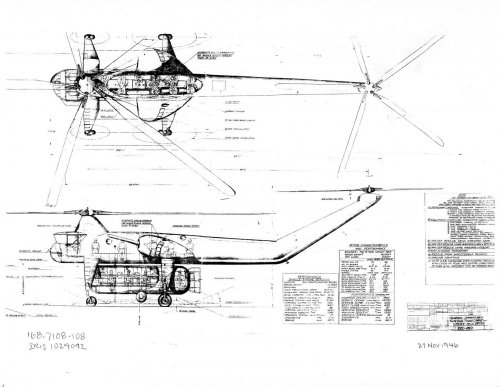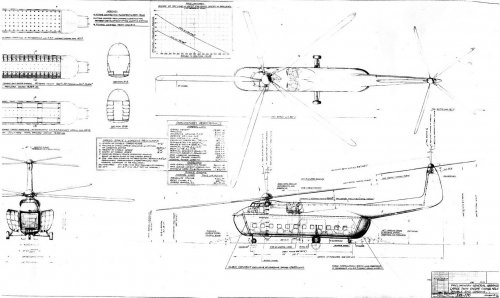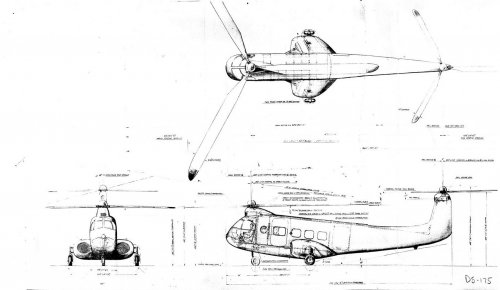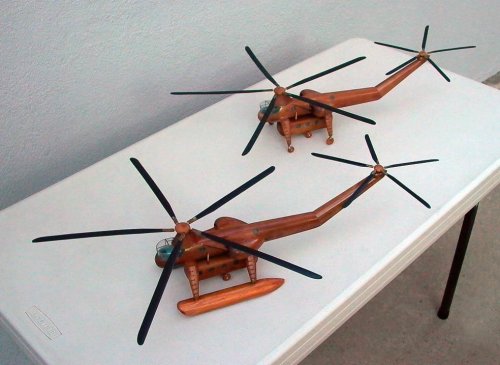Have recently come across some Sikorsky piston-engine helo projects from late 1946 and early 1947: the DS-160, DS-175 and DS-176. The DS-175 was a USN offering; the other two were presumably USAAF proposals.
You are using an out of date browser. It may not display this or other websites correctly.
You should upgrade or use an alternative browser.
You should upgrade or use an alternative browser.
Sikorsky Helo Projects, 1946-1947
- Thread starter Clioman
- Start date
- Joined
- 26 May 2006
- Messages
- 33,552
- Reaction score
- 13,657
Hi all,
for Sikorsky DS-175,I think it was intended to compete Piasecki PV-14 as a utility
helicopter to USN,I know Sikorsky submitted also its S-53 or XHJS to same competition,
remaining the DS-176 a mystery proposal for which contest,I will search in USAF
early tenders ?.
for Sikorsky DS-175,I think it was intended to compete Piasecki PV-14 as a utility
helicopter to USN,I know Sikorsky submitted also its S-53 or XHJS to same competition,
remaining the DS-176 a mystery proposal for which contest,I will search in USAF
early tenders ?.
I believe these early Sikorsky proposals date back to at least LATE 1943 from the information I got from the Hap Arnold Papers at the Library of Congress Today:
DATE 1 Dec 1943
COMMENT NO. 2
HGR/jgMc 72727
TO: Deputy Chief of Air Staff (Brig. Gen. William E. Hall)
FROM: Air Judge Advocate
Annexed hereto is memorandum for transmission to Julius H. Amberg, Esq., Special Assistant to the Secretary of War, outlining the present status of the helicopter program, as requested by Mr. Amberg's office.
EARL S. PATTERSON
Colonel, J.A.G.D.
Asst. Air Judge Advocate
Incl. Memo for Mr. Amberg, dtd 1 Dec 1943
MEMORANDUM FOR: Julius H. Amberg, Esq., Special Assistant to the Secretary of War (Attn: Lt. Col. Herbert A. Friedlich, J.A.G.D.)
SUBJECT: Status of Helicopter Program
1. Reference is made to memorandum from Colonel Friedlich addressed to the Commanding General, Army Air Forces, Subject: "Senate Investigation - Helicopters", dated 27 November 1943, requesting information concerning recent developments in the helicopter program.
2. Below is outlined the current status of the helicopter program:
a. New Designs and Construction. Five experimental models of helicopters are under current procurement. These are the Sikorsky XR-5 and XR-6, the Platt-LePage XR-1, the Kellett XR-8, and the G & A XR-9. In addition, Sikorsky has been invited to submit a proposal for a large helicopter with approximately 1,000 h.p. Besides these experimental aircraft, a number of Sikorsky YR-4's are being procured for service test by the Army Air Forces, British Royal Navy, and U. S. Navy. Contracts have been negotiated with Sikorsky for production quantities of R-4 and R-5 helicopters and with Nash-Kelvinator for production of Sikorsky designed R-6 helicopters. The various types of helicopters being developed or under construction are described in Appendix "A".
b. Miscellaneous Projects. The following miscellaneous projects and Investigations have been started:
e. Deliveries. Thirteen YR-4's have been delivered as of 13 November 1943, and delivery of the remaining aircraft will be made at the rate of at least one a week, with accelerated delivery schedules coming into effect approximately the last week in December, 1943. The first XR-5 has made a number of promising flight tests. The first XR-6A and the XR-1A are also undergoing flight test at the present time.
Incl. Appendix "A" (“Description of Helicopters Now Being Procured”)
1. Sikorsky Aircraft Division, United Aircraft Corporation All Sikorsky helicopters are of the single main rotor type, with an auxiliary rotor mounted on the side of the tail end of the fuselage to counteract the torque reaction of the main motor. The following models are being developed:
J. Kellett Aircraft Corporation. This company has a contract for two XR-8 helicopters. The XR-8 is a twin rotor type in which the axes of rotation are contained within the fuselage and form a "V", with the rotors overlapping and inter-meshing. This aircraft has a gross weight of approximately 2,700 pounds and is powered by a Franklin O-405-9 engine rated at 245 h.p. at sea level. Each rotor ie 36 feet in diameter, with the rotor disc centers four feet apart, giving a maximum span of 40 feet. A crew of two is carried.
4. G & A Aircraft Corporation. This company is being given a contract for two XR-9 helicopters. These aircraft are similar in external configuration to the Sikorsky helicopters, having a single main rotor and an auxiliary rotor at the tail. The rotor design is a new type which may eliminate several difficulties now encountered in rotary wing aircraft. The approximate gross weight of this aircraft is 1,280 pounds. A Lycoming 125 h.p. engine is installed, and the main rotor diameter is 28 feet. A crew of one is carried, however, provision is made for carrying a passenger as an overload condition.
Hap Arnold Papers, Library of Congress |
COMMENT NO. 2
HGR/jgMc 72727
TO: Deputy Chief of Air Staff (Brig. Gen. William E. Hall)
FROM: Air Judge Advocate
Annexed hereto is memorandum for transmission to Julius H. Amberg, Esq., Special Assistant to the Secretary of War, outlining the present status of the helicopter program, as requested by Mr. Amberg's office.
EARL S. PATTERSON
Colonel, J.A.G.D.
Asst. Air Judge Advocate
Incl. Memo for Mr. Amberg, dtd 1 Dec 1943
– – – – – – – – – – – – – – – – – – – – – – – – – – – – – – – – – – – – – – – –
AFAJA/HGR/jgMc
72727
1 December 1943
72727
1 December 1943
MEMORANDUM FOR: Julius H. Amberg, Esq., Special Assistant to the Secretary of War (Attn: Lt. Col. Herbert A. Friedlich, J.A.G.D.)
SUBJECT: Status of Helicopter Program
1. Reference is made to memorandum from Colonel Friedlich addressed to the Commanding General, Army Air Forces, Subject: "Senate Investigation - Helicopters", dated 27 November 1943, requesting information concerning recent developments in the helicopter program.
2. Below is outlined the current status of the helicopter program:
a. New Designs and Construction. Five experimental models of helicopters are under current procurement. These are the Sikorsky XR-5 and XR-6, the Platt-LePage XR-1, the Kellett XR-8, and the G & A XR-9. In addition, Sikorsky has been invited to submit a proposal for a large helicopter with approximately 1,000 h.p. Besides these experimental aircraft, a number of Sikorsky YR-4's are being procured for service test by the Army Air Forces, British Royal Navy, and U. S. Navy. Contracts have been negotiated with Sikorsky for production quantities of R-4 and R-5 helicopters and with Nash-Kelvinator for production of Sikorsky designed R-6 helicopters. The various types of helicopters being developed or under construction are described in Appendix "A".
b. Miscellaneous Projects. The following miscellaneous projects and Investigations have been started:
(1) Rotor Blade De-Icing. Princeton University, under a contract with the Army Air Forces, has constructed suitable test facilities for investigating rotor blade de-icing. Various possible methods of de-icing rotor blades have been, or will be, tried in an effort to determine the method most suitable for application to helicopters.
(2) Construction of all metal rotor blades. Fleetwings Division, Kaiser Cargoes, Incorporated, is being given a contract for construction of experimental all metal rotor blades incorporating a system for application of heat for anti-icing. Successful development of all metal blades to replace present types of rotor blades is considered essential.
(3) Development of rotor speed governors. General Electric Company, at the request of the Air Forces, has undertaken development of a constant speed rotor governor. This development work will be performed by General Electric in close liaison with the Army Air Forces and manufacturers of rotary wing aircraft.
(4) Construction of special torquemeters. Baldwin-Southwark is building, under contract with the Army Air Forces, special torquemeters for installation in the R-4 helicopter. These torque-meters will permit accurate determination of the power being furnished to main and auxiliary rotors.
c. Testing. The Air Forces has drawn up an extensive test program for rotary wing aircraft. Due to the new and novel nature of these aircraft, considerable basic data must be obtained. The following is a summary of tests and investigations which are now underway or are contemplated as aircraft and facilities become available:(5) A contract has been negotiated with Georgia School of Technology for a complete report on the helicopter being developed there. This helicopter is of new and unusual design, employing an engine driven blower and a jet of air for rotating a single blade.
(1) Complete flight investigation. These tests will include both aerodynamic and structural investigations. The results of the tests will be correlated with theory and wind tunnel tests. These tests were started with the XR-4 helicopter and are being continued with a YR-4B. Because of the wide scope of these investigations, additional aircraft will be used as they become available. At present it is planned to utilize at least one of each model in order that test data obtained from various aircraft may be made available.
(2) Construction of a test stand for structural testing of main rotor blades. This teat stand will be located at Wright Field. Whirl testing of rotor blades will, it is believed, became standard procedure in helicopter blade design as it has in propeller blade design.
(3) Investigation of the tactical utility of helicopters in performing Army Air Forces missions. One YR-4B Aircraft was flown to Ladd Field, Alaska, in a C-46 Airplane for tests of winter operations, suitability for rescue missions, et cetera. In addition, tests will be conducted in this country and in other theaters to determine suitability of the helicopter for performance of liaison and observation missions, evacuation of wounded, rescue of personnel and transportation of emergency supplies, adjustment of artillery fire, use by the Corps of Engineers, Signal Corps, et cetera. These tests depend on availability of aircraft.
d. Pilot and Mechanic Training. The Army Air Forces has arranged for the training of a number of pilots and mechanics by Sikorsky Aircraft. This training has been furnished to personnel of the British and the U.S. Navy as well as to Army Air Forces personnel. The Air Forces has drawn up a program for training pilots and mechanics, and this school will be activated in the Spring of 1944, when sufficient helicopters are available for training purposes.(4) The Army Air Forces is sponsoring a research program to be conducted by the N.A.C.A. A research program has been prepared by the Air Forces an- discussed with the N.A.C.A, This program is now getting underway. Additional items of research for which N.A.C.A. facilities are considered best suited will be incorporated in additional programs.
e. Deliveries. Thirteen YR-4's have been delivered as of 13 November 1943, and delivery of the remaining aircraft will be made at the rate of at least one a week, with accelerated delivery schedules coming into effect approximately the last week in December, 1943. The first XR-5 has made a number of promising flight tests. The first XR-6A and the XR-1A are also undergoing flight test at the present time.
For the Commanding General, Army Air Forces:
SIGNED
EARL S. PATTERSON
Colonel, J.A.G.D.
Asst. Air Judge Advocate
EARL S. PATTERSON
Colonel, J.A.G.D.
Asst. Air Judge Advocate
Incl. Appendix "A" (“Description of Helicopters Now Being Procured”)
– – – – – – – – – – – – – – – – – – – – – – – – – – – – – – – –
DESCRIPTION OF HELICOPTERS NOW BEING PROCURED
DESCRIPTION OF HELICOPTERS NOW BEING PROCURED
1. Sikorsky Aircraft Division, United Aircraft Corporation All Sikorsky helicopters are of the single main rotor type, with an auxiliary rotor mounted on the side of the tail end of the fuselage to counteract the torque reaction of the main motor. The following models are being developed:
a. YR-4A, YR-4B, R-4B. These aircraft have a gross weight of approximately 2,500 pounds, are powered by a Warner R-550-1 engine rated at 180 h.p. at sea level, and have a 38 foot diameter main rotor. A crew of two is carried. The YR-4B differs from the YR-4A in that it has provision for external attachment of bomb racks or an inclosed litter as an overload. The R-4B is the production version. Three YR-4A's, twenty-six YR-4B's, and one hundred R-4B's are being procured for the Army Air Forces, British Navy, and U.S. Navy.
b. XR-5, XR-5A, R-5A. These helicopters have a design gross weight of approximately 4,900 pounds, are powered by a Pratt-Whitney R-985-AN-5 engine rated at 450 h.p. at sea level and have a 48 foot diameter main rotor. A crew of two is carried. These aircraft have provision for carrying 700 pounds of bombs or four inclosed litters externally as an overload condition. In addition, the XR-5A and R-5A will have search equipment installed. The Army Air Forces are scheduled to receive two XR-5's and 100 R-5A's, the British are scheduled to receive two XR-5A's and two hundred and fifty R-5A's, and the U.S. Navy are scheduled to receive fifty R-5A's.
c. XR-6, XR-6A, R-6A. The XR-6A and R-6A aircraft have a gross weight of approximately 2,500 pounds, are powered by a Franklin O-405-9 engine rated at 245 h.p. at sea level, and have a 38 foot diameter rotor. A crew of two is carried. Provision is made for external attachment of bomb racks carrying 700 pounds of bombs or two inclosed litters as an overload condition. The XR-6 is similar to the XR-6A except that it will be powered by a Lycoming O-435-7 engine rated at 225 h.p. at sea level. One XR-6, one XR-6A, and eight hundred R-6A's are allocated to the Army, and three XR-6A's and one hundred R-6A's are allocated to the U.S. Navy.
2. Platt-LePage Aircraft Company. This company has contracts for two helicopters, the XR-1 and XR-1A. Both aircraft arc substantially similar and are of the twin rotor type, each rotor being mounted on a pylon extending laterally from the side of the fuselage. The XR-1 had been undergoing flight tests for some time, and appeared to be satisfactory when it was damaged in an accident in July, 1943. The XR-1A made its first flight in October, 1943, and it is believed that this aircraft will be satisfactory. At the present time the XR-1A is out of flying condition while minor adjustments are being made. Flight tests should be resumed before 1 December 1943. The XR-1 and XR-1A have a gross weight of approximately 4,900 pounds and have two rotors, each 30 1/2 fest in diameter. The XR-1 is powered by a 420 h.p. engine and the XR-1A by a 450 h.p. engine.d. Sikorsky is conducting a design study of a transport helicopter which will carry fourteen people, or equivalent cargo or litter cases. This aircraft will have a gross weight of 12,000 to 15,000 pounds and will be powered by an R-1830 engine rated at 1020 h.p. at sea level. This design study is expected to result in a proposal to the Army Air Forces for construction of an experimental article.
J. Kellett Aircraft Corporation. This company has a contract for two XR-8 helicopters. The XR-8 is a twin rotor type in which the axes of rotation are contained within the fuselage and form a "V", with the rotors overlapping and inter-meshing. This aircraft has a gross weight of approximately 2,700 pounds and is powered by a Franklin O-405-9 engine rated at 245 h.p. at sea level. Each rotor ie 36 feet in diameter, with the rotor disc centers four feet apart, giving a maximum span of 40 feet. A crew of two is carried.
4. G & A Aircraft Corporation. This company is being given a contract for two XR-9 helicopters. These aircraft are similar in external configuration to the Sikorsky helicopters, having a single main rotor and an auxiliary rotor at the tail. The rotor design is a new type which may eliminate several difficulties now encountered in rotary wing aircraft. The approximate gross weight of this aircraft is 1,280 pounds. A Lycoming 125 h.p. engine is installed, and the main rotor diameter is 28 feet. A crew of one is carried, however, provision is made for carrying a passenger as an overload condition.
Similar threads
-
Unidentified (supposedly Waco, maybe Douglas) pusher project
- Started by Stargazer
- Replies: 11
-
-
1946 USAAF Penetration Fighter (XF-88, XF-90)
- Started by devi
- Replies: 114
-
Contest with no prize: two airplanes to indentify
- Started by Skybolt
- Replies: 19
-




